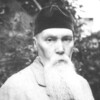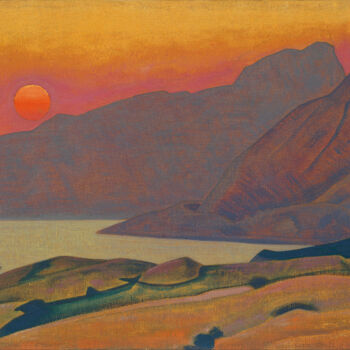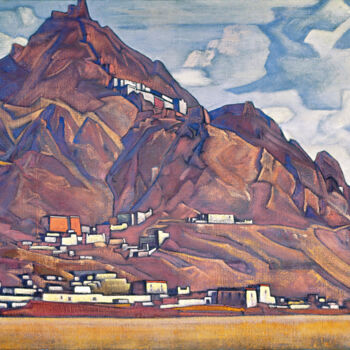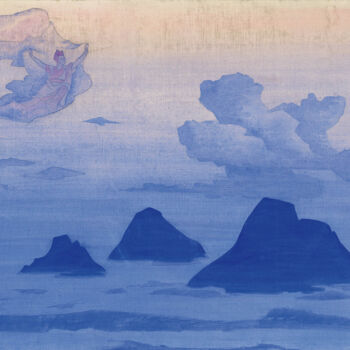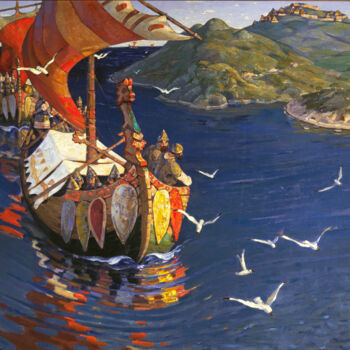Et nous essayons (1922) Painting by Nicolas Roerich
Seller Artmajeur Editions
Seller Artmajeur Editions
-
Original Artwork
Painting,
Oil
- Dimensions Height 28.2in, Width 40in
- Framing This artwork is not framed
- Categories Symbolism Landscape
Au sommet d'une colline, se dressait fièrement un château kremlin, sa silhouette imposante se détachant nettement contre le ciel jaune. Les murs de la forteresse, baignés de la chaleur du soleil, semblaient veiller sur la vallée en contrebas.
Au cœur de cette vue magnifique, une église élégante occupait le centre de l'image. Ses flèches pointaient vers le ciel, semblant presque toucher les nuages cotonneux qui se déplaçaient doucement. La lumière du soleil mettait en valeur les détails architecturaux de l'église, créant des jeux d'ombre et de lumière qui ajoutaient à sa beauté mystique.
Les trois personnes qui cheminaient avec leurs seaux d'eau semblaient se fondre harmonieusement dans ce décor enchanteur. Leurs silhouettes se détachaient devant ce paysage saisissant, ajoutant une touche de vie à cette scène d'une grande sérénité.
Ce tableau dégageait une atmosphère paisible et intemporelle, capturant la magie de l'instant présent, où l'histoire, la nature et la vie quotidienne se réunissaient en une seule harmonie.
Related themes
Nicolas Roerich (1874-1947) was a Russian-born artist, philosopher, archaeologist and humanitarian who made significant contributions to the worlds of art, culture and spirituality.
Born on October 9, 1874 in St. Petersburg, Russia, Roerich came from a family of intellectuals and was exposed to art and culture from an early age . He showed an early talent for painting and pursued studies at the Imperial Academy of Fine Arts in St. Petersburg.
Roerich became famous for his distinct style of symbolism and fascination for the mystical and the spiritual. He painted landscapes, portraits and scenes inspired by his travels in Russia and Asia. His works were often characterized by ethereal landscapes, ancient architecture and mystical symbols.
One of his most important contributions was his participation in a series of expeditions to Asia , notably in Tibet, India and Mongolia, between 1923 and 1930. These expeditions aimed to study and document the culture, art and history of the region. His travels deeply influenced his artistic work and philosophy.
Roerich was not only an artist, but also a philosopher and writer. He has written several books on Asian art, spirituality and cultural heritage. His writings often focused on themes such as peace, unity and the preservation of cultural treasures.
One of his most enduring legacies is the Roerich Pact, also known as the name 'Treaty on the Protection of Artistic and Scientific Institutions and Historic Monuments'. This international treaty, signed in 1935, aimed to protect cultural heritage in times of conflict. He laid the foundations for the protection of art and cultural heritage in times of war.
Roerich's work had a lasting impact on the art world and inspired many artists, particularly in the fields of mysticism and symbolism. His ideas on the unity of art and spirituality also influenced his contemporaries and subsequent generations.
Roerich spent the end of his life in India, where he established his residence and an art institute in the Himalayas. He continued to paint and promote his philosophical ideas until his death on December 13, 1947. His legacy lives on through his art, his writings, and continued efforts to preserve the world's cultural heritage.
-
Nationality:
RUSSIA

- Date of birth : 1874
- Artistic domains: Represented by a Gallery,
- Groups: Russian Contemporary Artists Artists presented by a gallery





